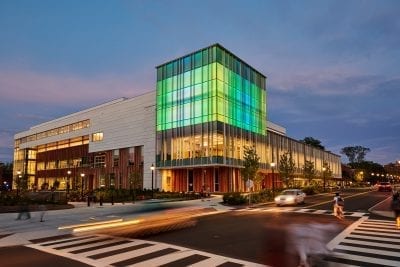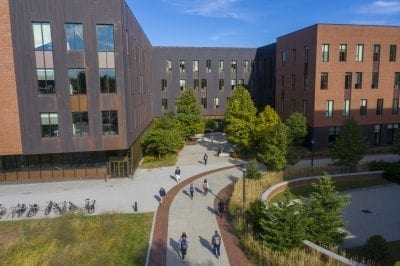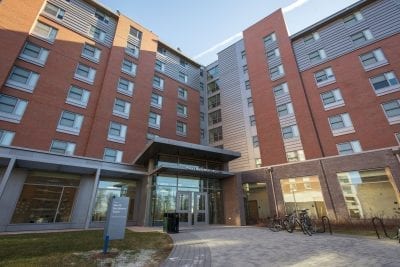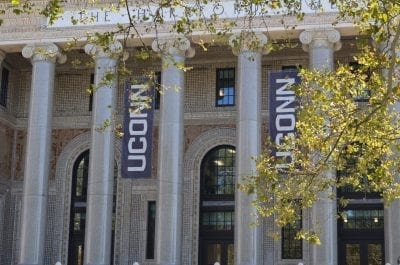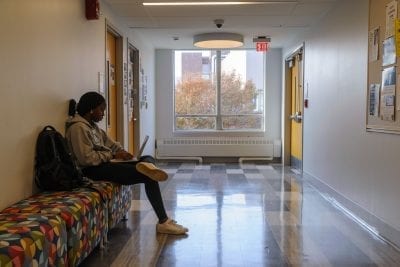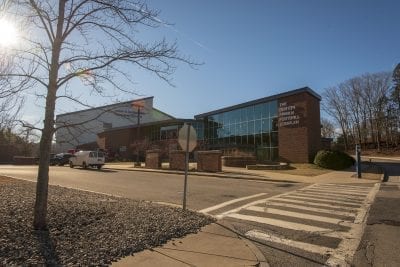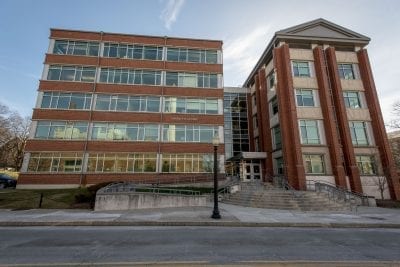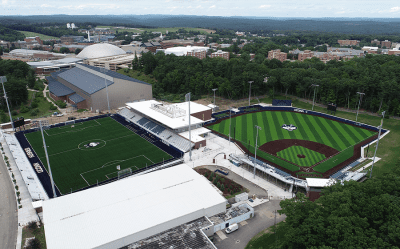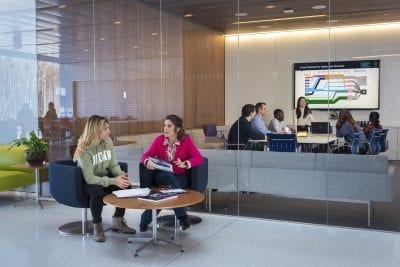
In 2016, the University adopted a new Sustainable Design and Construction Policy, stating that the University of Connecticut shall plan, design, construct, renovate and maintain sustainable, energy and water-efficient buildings.
All new construction projects at UConn estimated at greater than $5 million must pursue at least a LEED Gold rating.
The U.S. Green Building Council's LEED® rating system is the preeminent program for the design, construction, maintenance and operation of high-performance sustainable buildings.
Projects pursuing LEED certification earn points for various green building strategies across several categories. Based on the number of points achieved, a project earns one of four rating levels: Certified, Silver, Gold or Platinum. Explore our different projects below!
UConn LEED Projects
Gold
| Student Recreation Center: Completed for the fall of 2019, this building provides a new center for UConn's community to improve their well being, while also utilizing new tech and targeting SITES certification. |
|
|
Oak and McHugh Hall: Oak and McHugh Hall both achieved LEED Gold certification, the highest LEED ranking at UConn. Read more about McHugh (formerly Laurel) Hall's LEED Gold certification here. Oak and McHugh were constructed as replacement buildings for Arjona and Monteith, housing courses and departments such as Economics, Linguistics, Modern and Classical Languages, and Journalism. Both buildings have attained LEED Gold certification with green features such as window glazing, natural/adaptive and drought resistant plants, indoor air quality controls, low flow valves and faucets, extensive recycling of contruction waste (75% min.), use of rapidly renewable materials, green roof, use of regional materials, and bioretention swales
|
|
| Werth Tower: Werth Tower, formerly NextGen Hall, received LEED Gold Certification after construction was finished in 2016. It features a massive range of green features such as the green roof garden, solar heating panels, sunshades, light colored roofing, surrounding rain gardens, water bottle refill stations, advanced thermostats that can detect open windows, low flow water features, and more. The Residence Hall houses 8 different learning communities, each on their own floor. |
|
| UConn Hartford: The opening of this 157,000 sq ft building signified the establishment of UConn in the Connecticut capital city. The building was certified in 2019. |
|
| Science One/ STEM Research Center One |
Silver
| Henry Ruthven Monteith Hall: The major renovation completed in 2016 utilized a variety of green building strategies and materials to enhance the aesthetic value and environmental sensitivity of the space. Specific efforts included reducing the amount of construction waste sent to the landfill, selecting carpet and other interior finishes with high recycled content that emit fewer pollutants into the interior, which contributes to healthier indoor air quality and designing a ventilation strategy using mechanical and natural ventilation as well as installing LED lighting to significantly improve energy performance. |
|
| Burton-Shenkman Football Complex: The Football Complex and Training Center was the first LEED certified building on the UConn campus, in 2007. With its dual-flush toilets, lockers made from recycled content, green-label carpet, and with 89% of construction waste being recycled, it is also the first LEED Silver certified athletic complex in the NCAA. |
|
| Gentry Building Renovation: This 20,000 sq ft building houses many UConn education programs, and was certified in 2012. |
|
| Torrey Life Sciences Lab Renovation: This 8,630 sq ft building houses multiple UConn Biology Departments, and was certified in 2013. |
|
| Storrs Hall Addition: Certified in 2013, this addition is 15,380 sq ft. |
|
| Young Building Renovation: This 64,772 sq ft building houses UConn's Agricultural and Natural Resources Departments, and was certified in 2014. |
|
| Avery Point Student Center: Certified in 2014, this building is 15,657 sq ft. |
|
| Basketball Practice Facility: Certified in 2015, this building is 75,596 sq ft. |
|
| Main Accumulation Area: Certified in 2019, this building is 8,200 sq ft. |
|
| Engineering Science Building: Certified in 2019, this building is 94,719 sq ft. |
|
Certified
| Bousfield Psychology (Certified) |
|
| Athletic District (Certified) |
|
Registered Buildings
| Registered buildings have not yet been certified, and are either in design, in construction, or completed and pending certification. | |
| Innovation Partnership Building |
|
| Gant Complex Renovation | |
| Supplemental Utility Plant | |
| Putnam Renovation | |
| Whitney Dining Renovation | |
| Fine Arts Addition | |
|
|
|
|
|
|
SITES Projects and Rating System
SITES, or the Sustainable SITES Initiative, is a "set of comprehensive, voluntary guidelines" and rating system that grades the "sustainable design, construction, and maintenance of landscapes" (ASLA). It is used by various professionals to guide the design and development of land, and can apply to projects with or without buildings. SITES is owned and administered by the Green Business Certification Inc. (GBCI).
UConn SITES Projects
| Student Recreation Center (pending) | |
| Science 1/NW Quad (pending) | |
| Mansfield Apartments Redevelopment (pending) |
